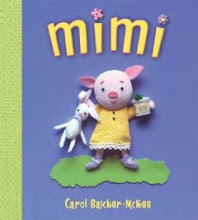 It has been positively wintry here for the last couple weeks, with several snows that have accumulated (well, at least more than a dusting). It's snowing now with 2-4 inches predicted today, more tomorrow and still more on Thanksgiving.
It has been positively wintry here for the last couple weeks, with several snows that have accumulated (well, at least more than a dusting). It's snowing now with 2-4 inches predicted today, more tomorrow and still more on Thanksgiving.On the whole, I am not a big fan of premature winter. I am already yearning for a Caribbean island. The only good thing about this weather is that it does put me in a cozy baking mood. The other day I decided to make some bread by hand, something I have not done since getting a breadmaker about 10 years ago. And oh my God, I'd forgotten how homemade bread is even better than breadmaker bread (which I do think is pretty tasty too). And especially I'd forgotten how wonderful this bread is, though it was my favorite as a teen, the first wholegrain bread I ever liked and the the first bread I learned to make myself (because my mother didn't bake it often enough to satisfy my cravings). I love this so much I made my mother bake dozens of loaves to serve at my wedding reception.
 I do not recall exactly where the recipe is from, though I'd guess from one of my mom's old Scandinavian cookbooks. (My mom's dad was Norwegian.) It's a bit of a bother, as any homemade bread is, but it's completely worth the trouble, even just for the way it makes the kitchen smell heavenly. And feel nice and warm.
I do not recall exactly where the recipe is from, though I'd guess from one of my mom's old Scandinavian cookbooks. (My mom's dad was Norwegian.) It's a bit of a bother, as any homemade bread is, but it's completely worth the trouble, even just for the way it makes the kitchen smell heavenly. And feel nice and warm.Swedish Sour Rye Bread
This makes 2 loaves, which is never enough. If you have a big enough bowl, maybe you should double the recipe.
2 cups thick sour milk
2/3 cup dark molasses
¼ cup salad oil (I use canola)
1 cake compressed yeast (OR 3 packets active dry yeast)
2 cups white flour
2 cups whole wheat flour
2 cups rye flour
2 tsp. salt
Extra flour for kneading
If you don’t have teens to help you make thick sour milk the old fashioned way (by leaving it on the counter all day after fixing their breakfast cereal), you can cheat by adding a few tablespoons of vinegar to the milk and letting it sit for 15 minutes – it should separate and look kind of nasty.) Heat the sour milk to lukewarm. I just beep it in the microwave, checking the temperature every 45 seconds or so. (All the liquid ingredients should be 110 to 115 degrees to activate the yeast, which means you'll want the milk to be a bit warmer than that, if you're the precise measure-y sort.) Pour the milk into a large bowl, and stir in the molasses, oil, and yeast. Put it aside to let the yeast get bubbly and gross-looking.
Sift the flours and salt together into a medium-size bowl. Stir the flour mixture into the milk mixture gradually, beating well after each addition. Turn the dough out onto a well-floured board and allow to rest 10 minutes or more.
Then put on some nice music or, my current favorite, podcasts of old episodes of NPR’s Wait, Wait, Don’t Tell Me and knead the dough until very smooth and elastic (10 minutes or more). You can sing loudly and annoy your children while you do this. Shape the dough into a ball and place in a large, well-greased bowl (I use olive oil to grease it). Turn the ball so it’s coated all over. Cover the bowl with a clean dishcloth and place it in a warm spot to rise until the dough is doubled in bulk (about 2 hours).
Punch down well and turn out on a lightly floured board. Divide the dough in half and shape into 2 loaves. Spray the loaf pans with Pam and put the loaves in them. Place them back in the warm spot, cover with the dishcloth again, and allow to rise until nearly doubled in bulk (2 hours). Bake at 350 degrees for 40-60 minutes until nicely browned and the edges are pulling away from the pan. (The loaves should also sound hollow when thumped.)
This makes 2 loaves, which is never enough. If you have a big enough bowl, maybe you should double the recipe.
2 cups thick sour milk
2/3 cup dark molasses
¼ cup salad oil (I use canola)
1 cake compressed yeast (OR 3 packets active dry yeast)
2 cups white flour
2 cups whole wheat flour
2 cups rye flour
2 tsp. salt
Extra flour for kneading
If you don’t have teens to help you make thick sour milk the old fashioned way (by leaving it on the counter all day after fixing their breakfast cereal), you can cheat by adding a few tablespoons of vinegar to the milk and letting it sit for 15 minutes – it should separate and look kind of nasty.) Heat the sour milk to lukewarm. I just beep it in the microwave, checking the temperature every 45 seconds or so. (All the liquid ingredients should be 110 to 115 degrees to activate the yeast, which means you'll want the milk to be a bit warmer than that, if you're the precise measure-y sort.) Pour the milk into a large bowl, and stir in the molasses, oil, and yeast. Put it aside to let the yeast get bubbly and gross-looking.
Sift the flours and salt together into a medium-size bowl. Stir the flour mixture into the milk mixture gradually, beating well after each addition. Turn the dough out onto a well-floured board and allow to rest 10 minutes or more.
Then put on some nice music or, my current favorite, podcasts of old episodes of NPR’s Wait, Wait, Don’t Tell Me and knead the dough until very smooth and elastic (10 minutes or more). You can sing loudly and annoy your children while you do this. Shape the dough into a ball and place in a large, well-greased bowl (I use olive oil to grease it). Turn the ball so it’s coated all over. Cover the bowl with a clean dishcloth and place it in a warm spot to rise until the dough is doubled in bulk (about 2 hours).
Punch down well and turn out on a lightly floured board. Divide the dough in half and shape into 2 loaves. Spray the loaf pans with Pam and put the loaves in them. Place them back in the warm spot, cover with the dishcloth again, and allow to rise until nearly doubled in bulk (2 hours). Bake at 350 degrees for 40-60 minutes until nicely browned and the edges are pulling away from the pan. (The loaves should also sound hollow when thumped.)
Try to let it cool a bit, but go ahead and have some while it's still warm. I'll happily eat it plain, but it's extra incredible with some real butter or a little honey. Or made into sandwiches with your Thanksgiving turkey leftovers. Or with cold turkey meatloaf, which I'll give you the recipe for later, when you're no longer sick of the bird. My family knows to grab some quickly, otherwise, I'll eat it all while they're off at work or school.




















No comments:
Post a Comment